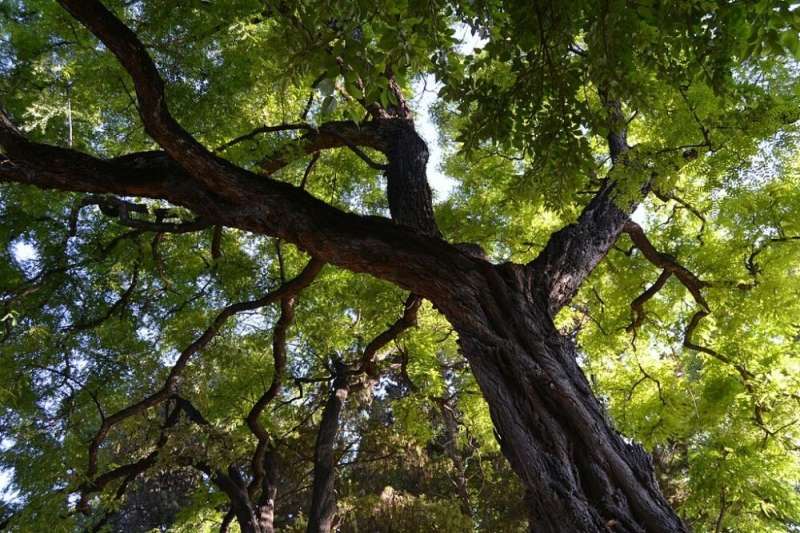Air pollution affects tree growth in Sao Paulo

As well as causing significant harm to human health, air pollution also stunts the growth of trees, one of the elements that can attenuate this typically urban environmental problem.
Researchers at the University of São Paulo (USP) in Brazil have shown that atmospheric pollutants restrict tree growth and the ecosystem services provided by trees, such as filtering pollution by absorbing airborne metals in their bark, assimilating CO2, reducing the heat island effect by attenuating solar radiation, mitigating stormwater runoff, and controlling humidity.
The study results have been published in the journal Science of the Total Environment.
"We found that in years when levels of particulate matter in the atmosphere were higher, for example, the trees grew less. As a result, they started later in their lives to provide ecosystem services that play an important role in reducing urban pollution and mitigating or adapting the city to climate change," said Giuliano Maselli Locosselli, a postdoctoral researcher at the University of São Paulo's Bioscience Institute (IB-USP) with a scholarship from FAPESP and first author of the study.
Using as a model the tipuana tree (Tipuana tipu), also known as rosewood or tipu, a tall tree with a large spreading canopy and ubiquitous in the city, the researchers measured the impact of air pollution and weather on tree growth in São Paulo. They analyzed samples of 41 tipuanas aged 36 on average and located at different distances from the Capuava industrial estate in Mauá, a municipality in the metropolitan area. Capuava is one of the most industrialized districts in the region, with oil refineries, cement plants and fertilizer factories, as well as heavy truck and car traffic.
Samples were taken from the trees' growth rings using an instrument called a Pressler increment borer, which has a hollow auger bit and is designed to extract a cylindrical section of wood tissue from a living tree throughout its radius with relatively minor injury to the plant. All samples were taken at chest height, approximately 1.3 m from the topsoil.
By analyzing the chemical composition of the bark and the size of the growth rings, the researchers were able to measure variations in air pollution levels based on the various chemical elements to which the trees were exposed during their development and to estimate how this factor influenced tree growth.
"The tipuana is an excellent marker that clearly represents levels of air pollution by heavy metals and other chemical elements in the city," Locosselli said.
Metals and other chemicals suspended in the air are absorbed by bark. Particulate matter is deposited on leaves, increasing their temperature and reducing the supply of light for photosynthesis. Growth rings indicate how pollution has affected the life of the plant year by year. Thicker rings indicate years of vigorous growth and lower levels of pollution, while thinner rings indicate the reverse.
Analysis of growth rings showed that these tipuanas grew faster in the warmer parts of Capuava with higher levels of phosphorus in the air. Phosphorus is a known macronutrient for plants and acts as the basis of their energy metabolism via photosynthesis and respiration.
On the other hand, trees close to traffic and exposed to high levels of aluminum, barium and zinc associated with the wearing of automotive parts (such as tires, brake linings and clutch plates) displayed less growth over time.
Particulate matter with a diameter of up to 10 micrometers (PM10) emitted by factories and plants reduced average tree growth by as much as 37%.
"Trees exposed directly to high levels of pollution from the factories in the area grew less in terms of trunk diameter development throughout their lives than plants exposed to medium and low levels," Locosselli said. "Under normal growth conditions, a tipuana's chest-height diameter can reach 1 meter."
Time series for levels of PM10 in Capuava over a 20-year period were obtained from the São Paulo State Environmental Corporation (CETESB) and compared with the results of the bark and leaf analysis.
The researchers found PM10 levels to account for 41% of interannual tree growth rate variability, with higher levels of pollution during the driest months (April-September) reducing the growth rate.
"Diameter increases very quickly when the tree is growing normally but changes little when the growth rate is slow," Locosselli said. "The magnitude of the ecosystem services provided by a tall tree can be 70 times greater than for a small tree."
Effects on trees
According to the authors of the study, heavy metals and particulate matter influence tree growth by changing the optical properties of leaf surfaces. As mentioned, these pollutants raise temperatures and reduce the availability of light for photosynthesis. They may also reduce gas exchange due to accumulation on leaf stomata (pores that open and close to allow the intake of carbon dioxide and the release of oxygen).
"We plan to try to find out whether pollution also affects the longevity of these trees. Given that pollution restricts various physiological systems, hampering plant growth, it probably also makes them more vulnerable to effects that lead to senescence," said Marcos Buckeridge, a professor in IB-USP and principal investigator for the research project.
Urban pollution probably also damages other species in the same family as tipuana found in São Paulo, such as partridgewood (Caesalpinia pluviosa) and ironwood (C. leiostachya).
"Measures to reduce air pollution, such as fostering biofuel use, the electrification of transport and the development of materials to decrease emissions of heavy metals, could enhance the maintenance of these trees and the ecosystem services they provide," Buckeridge said.
More information: Giuliano Maselli Locosselli et al, The role of air pollution and climate on the growth of urban trees, Science of The Total Environment (2019). DOI: 10.1016/j.scitotenv.2019.02.291
Journal information: Science of the Total Environment
Provided by FAPESP




















